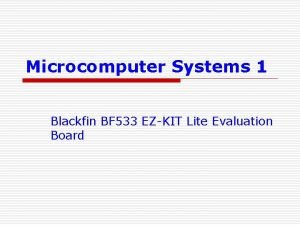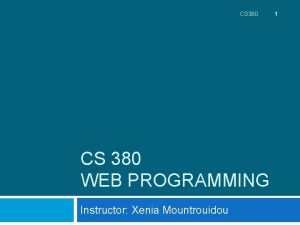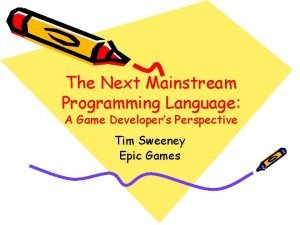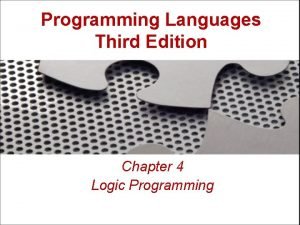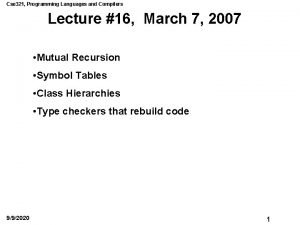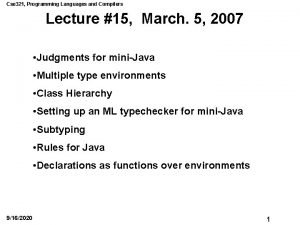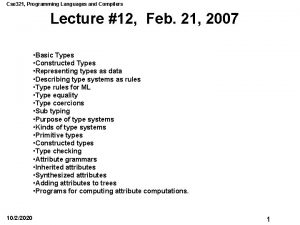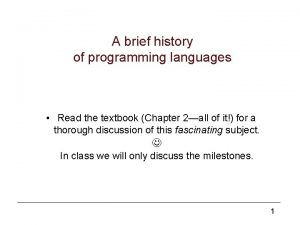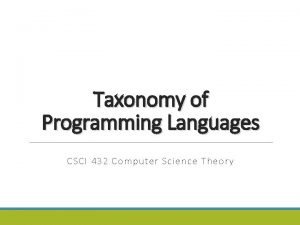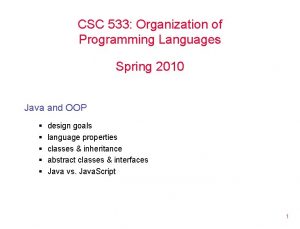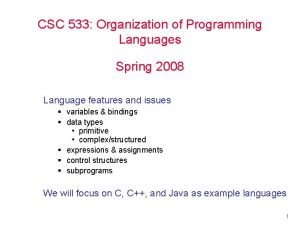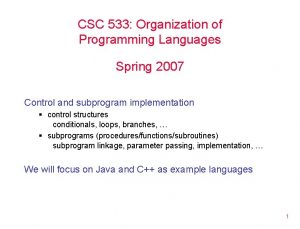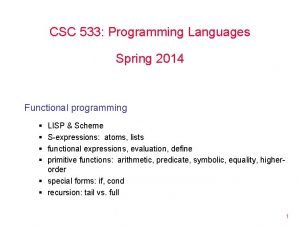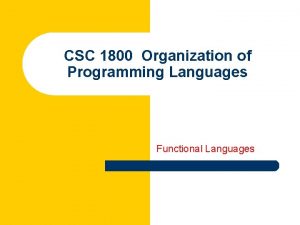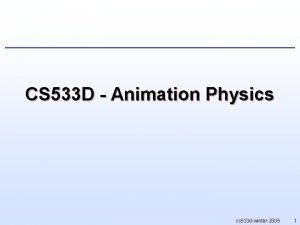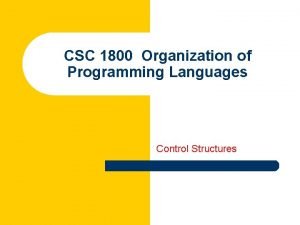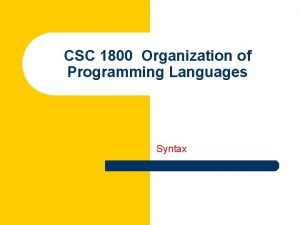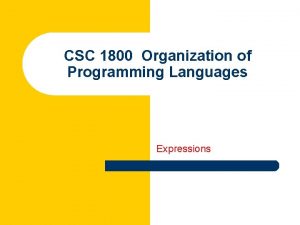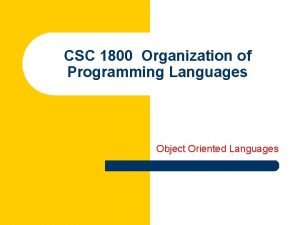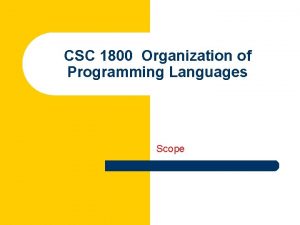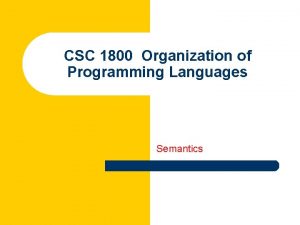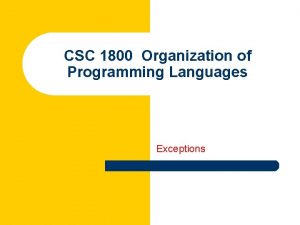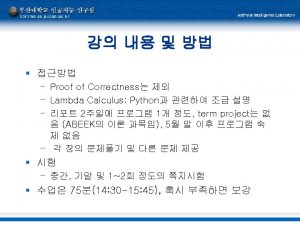CSC 533 Organization of Programming Languages Spring 2010


























- Slides: 26

CSC 533: Organization of Programming Languages Spring 2010 Background § machine assembly high-level languages § software development methodologies § key languages Syntax § grammars, BNF § derivation trees, parsing § EBNF, syntax graphs Semantics § operational, axiomatic, denotational 1

Evolution of programming first computers (e. g. , ENIAC) were not programmable § had to be rewired/reconfigured for different computations late 40’s / early 50’s: coded directly in machine language § extremely tedious and error prone § machine specific § used numeric codes, absolute 0111111101000101010011000110000000010000000000000000000000000000000001000000000000000000000000000000000000101000000000000000110100000000000000000000001010000001000000000100000101110011011010000111001101000111 00100111010001100001011000000010111010001100101011110000111010000101110010011011001000110000101110100011000000000010111001101111001011011010111010001100001011000000010111001101 0001110010011101000110000101100000001011100100101011011000110 000100101110100011001010111100001110100000010111000110110111101 101101011001010110111010000000000000000010011101 11100011111110010000000100110000000000001001000000010010011000 000000010101000000000000100100100101010000000100 0000000000000000001000000000000101000010000001000100100000000001000000010101000000000000 1001001001010100000000000000000000000001000000000101100000000000100000000000001000000000000100000011111100000100000011110100000000000000000000000010010000110010101101100 0110111011011110010011011001000010000000000000000000001000000000000000000100000111111000100000000010000000000000000000000000000000010000011111100010000000000000000000000000000110000000000000000000000000000000000000100000000000000000000000000000000000110000000010000000000000011010000000000000000000100000000000000000000100000000000000000000000000000010000000000000000000000000001000110000000000000000000000000000001000000000000000000101100000000000000000001000000000000000000000001101001000000000000000000000000000001001000000000000000000000000001101110000000000000000000000000001000000000000110100001100101011011000110111100101110001101110000000110011101100011001001011111011000110110110 10111000001101001011011001010110010000101110000010111110101000101011 11100010111010001101100100000010111110110110001110011010 11111010111110011011110111001101000111001001010110000101101101000001100100011011110111001101000111001001010110000 101101101010111110101001000110111101110011010001110010010101100 001011011010000010111110110110001110011010111110011011 011110011010001110010010101100001011011010000011011000110 0000110010101101110010001101100010111110100011001000110110111001101000111001001010110000101101101000001101100 001011011100000110001101101110101011101000000000000000000000000000 2

Evolution of programming (cont. ) mid 1950’s: assembly languages developed § mnemonic names replaced numeric codes § relative addressing via names and labels a separate program (assembler) translated from assembly code to machine code • still machine specific, lowlevel . file "hello. cpp" gcc 2_compiled. : . global _Q_qtod. section ". rodata". align 8. LLC 0: . asciz "Hello world!". section ". text". align 4. global main. type main, #function. proc 04 main: !#PROLOGUE# 0 save %sp, -112, %sp !#PROLOGUE# 1 sethi %hi(cout), %o 1 or %o 1, %lo(cout), %o 0 sethi %hi(. LLC 0), %o 2 or %o 2, %lo(. LLC 0), %o 1 call __ls__7 ostream. PCc, 0 nop mov %o 0, %l 0 mov %l 0, %o 0 sethi %hi(endl__FR 7 ostream), %o 2 or %o 2, %lo(endl__FR 7 ostream), %o 1 call __ls__7 ostream. PFR 7 ostream_R 7 ostream, 0 nop mov 0, %i 0 b. LL 230 nop. LL 230: ret restore. LLfe 1: . size main, . LLfe 1 -main. ident "GCC: (GNU) 2. 7. 2" 3

Evolution of programming (cont. ) late 1950’s: high-level languages developed § allowed user to program at higher level of abstraction however, bridging the gap to lowlevel hardware was more difficult • a compiler translates code all at once into machine code (e. g. , FORTRAN, C++) • an interpreter simulates execution of the code line-by-line (e. g. , BASIC, Scheme) // File: hello. cpp // Author: Dave Reed // // This program prints "Hello world!" //////////////////// #include <iostream> using namespace std; int main() { cout << "Hello world!" << endl; return 0; } Java utilizes a hybrid scheme • source code is compiled into byte code • the byte code is then interpreted by the Java Virtual Machine (JVM) that is built into the JDK or a Web browser 4

Software development methodologies by 70’s, software costs rivaled hardware new development methodologies emerged early 70’s: top-down design § stepwise (iterative) refinement (Pascal) late 70’s: data-oriented programming § concentrated on the use of ADT’s (Modula-2, Ada, C/C++) early 80’s: object-oriented programming § ADT’s+inheritance+dynamic binding (Smalltalk, C++, Eiffel, Java) Software Engineering processes: waterfall model, extreme programming, agile programming 5

Architecture influences design virtually all computers follow the von Neumann architecture fetch-execute cycle: repeatedly • fetch instructions/data from memory • execute in CPU • write results back to memory imperative languages parallel this behavior § variables (memory cells) § assignments (changes to memory) § sequential execution & iteration (fetch/execute cycle) since features resemble the underlying implementation, tend to be efficient declarative languages emphasize problem-solving approaches far-removed from the underlying hardware e. g. , Prolog (logic): specify facts & rules, interpreter performs logical inference LISP/Scheme (functional): specify dynamic transformations to symbols & lists tend to be more flexible, but not as efficient 6

FORTRAN (Formula Translator) FORTRAN was the first* high-level language § developed by John Backus at IBM § designed for the IBM 704 computer, all control structures corresponded to 704 machine instructions § 704 compiler completed in 1957 C C FORTRAN program Prints "Hello world" 10 times PROGRAM HELLO DO 10, I=1, 10 PRINT *, 'Hello world' 10 CONTINUE STOP END § despite some early problems, FORTRAN was immensely popular – adopted universally in 50's & 60's § FORTRAN evolved based on experience and new programming features • FORTRAN II (1958) • FORTRAN IV (1962) • FORTRAN 77 (1977) 7

LISP (List Processing) LISP is a functional language § developed by John Mc. Carthy at MIT § designed for Artificial Intelligence research – needed to be symbolic, flexible, dynamic § LISP interpreter completed in 1959 § LISP syntax is very simple but flexible, based on the l-calculus of Church § all memory management is dynamic and automatic – simple but inefficient § LISP is still the dominant language in AI ; ; ; LISP program ; ; ; (hello N) will return a list containing ; ; ; N copies of "Hello world" (define (hello N) (if (zero? N) '() (cons "Hello world" (hello (- N 1))))) > (hello 10) ("Hello world" "Hello world" "Hello world") > 8

ALGOL (Algorithmic Language) ALGOL was an international effort to design a universal language § developed by joint committee of ACM and GAMM (German equivalent) § influenced by FORTRAN, but more flexible & powerful, not machine specific comment ALGOL 60 PROGRAM displays "Hello world" 10 times; begin integer counter; for counter : = 1 step 1 until 10 do begin printstring(Hello world"); end § ALGOL introduced and formalized many common language features of today • data type • compound statements • natural control structures • parameter passing modes • recursive routines • BNF for syntax (Backus & Naur) § ALGOL evolved (58, 60, 68), but not widely adopted as a programming language 9

C C++ Java. Script ALGOL influenced the development of virtually all modern languages § C (1971, Dennis Ritchie at Bell Labs) • designed for system programming (used to implement UNIX) • provided high-level constructs and low-level machine access § C++ (1985, Bjarne Stroustrup at Bell Labs) • extended C to include objects • allowed for object-oriented programming, with most of the efficiency of C § Java (1993, Sun Microsystems) • based on C++, but simpler & more reliable • purely object-oriented, with better support for abstraction and networking #include <stdio. h> main() { for(int i = 0; i < 10; i++) { printf ("Hello World!n"); } } #include <iostream> using namespace std; int main() { for(int i = 0; i < 10; i++) { cout << "Hello World!" << endl; } return 0; } public class Hello. World { public static void main (String args[]) { for(int i = 0; i < 10; i++) { System. out. println("Hello World "); } } } <html> <body> <script type="text/javascript"> for(i = 0; i < 10; i++) { document. write("Hello World "); } </script> </body> </html> 10

Other influential languages COBOL (1960, Dept of Defense/Grace Hopper) § designed for business applications, features for structuring data & managing files BASIC (1964, Kemeny & Kurtz – Dartmouth) § designed for beginners, unstructured but popular on microcomputers in 70's Simula 67 (1967, Nygaard & Dahl – Norwegian Computing Center) § designed for simulations, extended ALGOL to support classes/objects Pascal (1971, Wirth – Stanford) § designed as a teaching language but used extensively, emphasized structured programming Prolog (1972, Colmerauer, Roussel – Aix-Marseille, Kowalski – Edinburgh) § logic programming language, programs stated as collection of facts & rules Ada (1983, Dept of Defense) 11

There is no silver bullet remember: there is no best programming language § each language has its own strengths and weaknesses languages can only be judged within a particular domain or for a specific application business applications COBOL artificial intelligence LISP/Scheme or Prolog systems programming C software engineering C++ or Java or Smalltalk Web development Java or Java. Script or php or Ruby or … 12

Syntax syntax: the form of expressions, statements, and program units in a programming language programmers & implementers need a clear, unambiguous description formal methods for describing syntax: § Backus-Naur Form (BNF) developed to describe ALGOL (originally by Backus, updated by Naur) allowed for clear, concise ALGOL 60 report (paralleled grammar work by Chomsky: BNF = context-free grammar) § Extended BNF (EBNF) § syntax graphs 13

BNF is a meta-language a grammar is a collection of rules that define a language § BNF rules define abstractions in terms of terminal symbols and abstractions <ASSIGN> <VAR> : = <EXPRESSION> § rules can be conditional using ‘|’ to represent OR <IF-STMT> if <LOGIC-EXPR> then <STMT> | if <LOGIC-EXPR> then <STMT> else <STMT> § arbitrarily long expressions can be defined using recursion <IDENT-LIST> <IDENTIFIER> | <IDENTIFIER> , <IDENT-LIST> 14

Deriving expressions from a grammar from ALGOL 60: <letter> a | b | c |. . . | z | A | B |. . . | Z <digit> <identifier> 0 | 1 | 2 |. . . | 9 <letter> | <identifier> <digit> can derive language elements by substituting definitions for abstractions: a hierarchical representation of a derivation is known as a parse tree – internal nodes are abstractions – leaf nodes are terminal symbols the derived element is read left-to-right across the leaves (here, CU 1) 15

Ambiguous grammars consider a grammar for simple assignments <assign> <id> <expr> <id> : = <expr> A | B | C <expr> + <expr> | <expr> * <expr> | ( <expr> ) | <id> A grammar is ambiguous if there exist sentences with 2 or more distinct parse trees e. g. , A : = A + B * C 16

Ambiguity is bad! programmer perspective § need to know how code will behave language implementer’s perspective § need to know how the compiler/interpreter should behave can build concepts such as operator precedence into grammars § introduce a hierarchy of rules, lower level higher precedence <assign> <id> <expr> <term> <factor> <id> : = <expr> A | B | C <expr> + <term> | <term> * <factor> | <factor> ( <expr> ) | <id> higher precedence operators bind tighter, e. g. , A+B*C ≡ A+(B*C) 17

Operator precedence <assign> <id> <expr> <term> <factor> <id> : = <expr> A | B | C <expr> + <term> | <term> * <factor> | <factor> ( <expr> ) | <id> Note: because of hierarchy, + must appear above * in the parse tree here, if tried * above, would not be able to derive + from <term> In general, lower precedence (looser bind) will appear above higher precedence operators in the parse tree (i. e. , closer to root) 18

Operator associativity similarly, can build in associativity § left-recursive definitions left-associative § right-recursive definitions right-associative <assign> <id> : = <expr> <id> A | B | C <expr> + <term> | <term> * <factor> | <factor> ( <expr> ) | <id> 19

Right associativity suppose we wanted exponentiation ^ to be right-associative § need to add right-recursive level to the grammar hierarchy <assign> <id> : = <expr> <id> A | B | C <expr> + <term> | <term> * <factor> | <factor> <exp> ^ <factor> | <exp> ( <expr> ) | <id> 20

In ALGOL 60… <simple math> | <if clause> <simple math> else <math expr> <if clause> if <boolean expr> then <simple math> <term> | <add op> <term> | <simple math> <add op> <term> <math expr> <term> <factor> | <term> <mult op> <factor> <primary> | <factor> ↑ <primary> <add op> <mult op> <primary> | + | х | / | % <unsigned number> | <variable> <function designator> | ( <math expr> ) precedence? associativity? 21

Dangling else consider the Java/C++/C grammar rule: <selection stmt> if ( <expr> ) <stmt> | if ( <expr> ) <stmt> else <stmt> potential problems? if (x > 0) if (x > 100) System. out. println("foo"); else System. out. println("bar"); ambiguity! • to which ‘if’ does the ‘else’ belong? in Java/C++/C, ambiguity remains in the grammar rules • is clarified in the English description (else matches nearest if) 22

Dangling else in ALGOL 60? <stmt> <uncond stmt> | <for stmt> <uncond stmt> <basic stmt> | <compound stmt> begin <stmt sequence> end <cond stmt> <if clause> <if stmt> | <if stmt> else <stmt> | <if clause> <for stmt> <if clause> <uncond stmt> if <boolean expr> then if x > y then if y > z then is this legal in ALGOL 60? printstring("foo"); else printstring("bar"); ambiguous? 23

Extended BNF (EBNF) extensions have been introduced to increase of expression § brackets denote optional features <writeln> writeln [ <item list> ] § braces denote arbitrary # of repetitions (including 0) <ident list> <identifier> { , <identifier> } § ( | ) denotes optional sub-expressions <for stmt> for <var> : = <expr> (to | downto) <expr> do <stmt> Note: could express these in BNF, but not as easily 24

BNF vs. syntax graphs see BNF Web Club for various language grammars § each grammar rule for a language is indexed § in addition to BNF, syntax graphs are given § note simplicity of LISP 25

Semantics generally much trickier than syntax 3 common approaches § operational semantics: describe meaning of a program by executing it on a machine (either real or abstract) Pascal code for i : = first to last do begin … end Operational semantics loop: out: i = first if i > last goto out … i = i + 1 goto loop … § axiomatic semantics: describe meaning using assertions about conditions, can prove properties of program using formal logic Pascal code while (x > y) do begin … end Axiomatic semantics while (x > y) do begin ASSERT: x > y … end ASSERT: x <= y § denotational semantics: describe meaning by constructing a detailed mathematical model of each language entity – PRECISE, BUT VERY EXACTING! 26
 Bf-533
Bf-533 Bae yong-kyun
Bae yong-kyun Spring autumn winter
Spring autumn winter Real-time systems and programming languages
Real-time systems and programming languages Cs 421 uiuc
Cs 421 uiuc Multithreaded programming languages
Multithreaded programming languages Programming languages levels
Programming languages levels Introduction to programming languages
Introduction to programming languages Plc coding language
Plc coding language Procedural programming languages
Procedural programming languages Imperative programming languages
Imperative programming languages Alternative programming languages
Alternative programming languages Strongly typed vs weakly typed
Strongly typed vs weakly typed Transmission programming languages
Transmission programming languages Adam doupe cse 340
Adam doupe cse 340 Integral data type
Integral data type Xenia programming languages
Xenia programming languages Advantages of application software
Advantages of application software Mainstream programming languages
Mainstream programming languages Vineeth kashyap
Vineeth kashyap Programing languages
Programing languages Programming languages
Programming languages Programming languages
Programming languages Programming languages
Programming languages Attribute grammar in principles of programming languages
Attribute grammar in principles of programming languages Brief history of programming languages
Brief history of programming languages Lisp_q
Lisp_q
